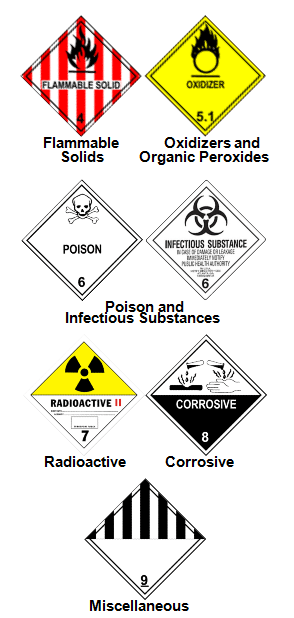
On Tuesday we covered the first three classes of hazardous waste classes including explosives, gasses, and flammable liquids. Today, we are going to cover the remaining 6 classes as well as the ORM (other regulated materials) definitions. To refresh your memory, a hazard class is the category of hazard assigned to a hazardous material under the definitional criteria of 49 CFR Part 173 and the provisions of the HMT at §172.101. A material may meet the defining criteria for more than one hazard class but is assigned to only one hazard class. That said, read on for the definitional criteria of classes 4-9.
Class 4
- Division 4.1 – Flammable Solid – Explosives wetted with sufficient water, alcohol, or plasticizer to explosive properties that when dry are Class 1 explosives and self-reactive explosives that are liable to undergo at normal or elevated temperatures a strongly exothermal decomposition caused by high transport temperatures or by contamination. Also included in this definition are readily combustible solids that may cause a fire through friction, have a burning rate faster than 2.2 mm (0.087 inches) per second, or any ignitable metal powders. Ref. 173.124(a).
- Division 4.2 – Spontaneously combustible materials – Includes pyrophoric material, which is a liquid or solid that even in small quantities and without an external ignition source can ignite within five minutes after coming into contact with air; and self-heating material, which is liable to self-heat when it comes into contact with air even without an energy source. Ref. 173.124(b).
- Division 4.3 – Dangerous when wet materials – A material that by contact with water is liable to become spontaneously flammable or to give off flammable or toxic gas at a rate greater than one liter per kilogram of the material per hour. Ref. 173.124(c).
Class 5
- Division 5.1 – Oxidizer – A material that may by yielding oxygen cause or enhance the combustion of other materials. Ref. 173.127(a).
- Division 5.2 – Organic peroxide – Any organic compound containing oxygen in the bivalent -O-O structure and which may be considered a derivative of hydrogen peroxide where one or more of the hydrogen atoms have been replaced by organic radicals, must be classed as an organic peroxide unless: it classifies as an explosive; the predominant hazard of the material is other than from an organic peroxide; the material is forbidden for transport; or the material will not pose a hazard in transport. Ref. 173.128(a).
Class 6
- Division 6.1 – Poisonous materials – A material, other than a gas, which is known to be so toxic to humans as to afford a hazard to health during transportation; or the material is presumed to be toxic because there is evidence of oral, dermal, and/or inhalation toxicity in laboratory animals. Ref. 173.132(a).
- Division 6.2 – Infectious substance or etiologic agent – A viable microorganism, or its toxin, which causes or may cause disease in humans or animals. Ref. 173.134(a).
Class 7
- Radioactive Material – Any material, or combination of materials, that spontaneously emits ionizing radiation, and having a specific activity greater than 0.002 microcuries per gram. Ref. 173.403.
Class 8
- Corrosive Material – A liquid or solid that causes visible destruction or irreversible alterations in human skin tissue at the site of contact, or a liquid that has a severe corrosion rate on steel or aluminum. Ref. 173.136(a).
Class 9
- Miscellaneous hazardous material – A material that presents a hazard during transport but is not included in any other hazard class. Ref. 173.140(a) and (b).
ORM – Other Regulated Materials – A material such as a consumer commodity that, though otherwise subject to DOT regulations, presents a limited hazard during transportation due to its form, quantity and packaging. Ref. 173.144.
More News From Heritage
-
3/12/24
Equal Pay Day – Spotlighting Our Female Drivers
-
3/8/24
International Women’s Week Spotlight – Shannon Dippel
For International Women's Week, we're spotlighting some of the incredible women in the Heritage family. Our final spotlight is Shannon Dippel.
-
3/8/24
International Women’s Week Spotlight – Susan Adams
For International Women's Week, we're spotlighting some of the incredible women in the Heritage family. Our sixth spotlight is Susan Adams.
-
3/7/24
International Women’s Week Spotlight – Lea Wilson
For International Women's Week, we're spotlighting some of the incredible women in the Heritage family. Our fifth spotlight is Lea Wilson
-
3/7/24
International Women’s Week Spotlight – Melissa Fisk
For International Women's Week, we're spotlighting some of the incredible women in the Heritage family. Our fourth spotlight is Melissa Fisk.
-
3/6/24
International Women’s Week Spotlight – Taylor Harvey
For International Women's Week, we're spotlighting some of the incredible women in the Heritage family. Our third spotlight is Taylor Harvey
-
3/5/24
International Women’s Week Spotlight – Karen Esquivel
For International Women's Week, we're spotlighting some of the incredible women in the Heritage family. Our second spotlight is Karen Esquivel.
-
3/5/24
Heritage Environmental Services Announces HP Nanda as CEO; CEO Jeff Laborsky Transitions to Board of Directors
Heritage Environmental Services (“HES”) announced today that HP Nanda will join the organization as CEO.








